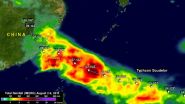(Press-News.org) MADISON, Wis. -- Graphene, an atom-thick material with extraordinary properties, is a promising candidate for the next generation of dramatically faster, more energy-efficient electronics. However, scientists have struggled to fabricate the material into ultra-narrow strips, called nanoribbons, that could enable the use of graphene in high-performance semiconductor electronics.
Now, University of Wisconsin-Madison engineers have discovered a way to grow graphene nanoribbons with desirable semiconducting properties directly on a conventional germanium semiconductor wafer. This advance could allow manufacturers to easily use graphene nanoribbons in hybrid integrated circuits, which promise to significantly boost the performance of next-generation electronic devices. The technology could also have specific uses in industrial and military applications, such as sensors that detect specific chemical and biological species and photonic devices that manipulate light.
In a paper published Aug. 10 in the journal Nature Communications, Michael Arnold, an associate professor of materials science and engineering at UW-Madison, Ph.D. student Robert Jacobberger, and their collaborators describe their new approach to producing graphene nanoribbons. Importantly, their technique can easily be scaled for mass production and is compatible with the prevailing infrastructure used in semiconductor processing.
"Graphene nanoribbons that can be grown directly on the surface of a semiconductor like germanium are more compatible with planar processing that's used in the semiconductor industry, and so there would be less of a barrier to integrating these really excellent materials into electronics in the future," Arnold says.
Graphene, a sheet of carbon atoms that is only one atom in thickness, conducts electricity and dissipates heat much more efficiently than silicon, the material most commonly found in today's computer chips. But to exploit graphene's remarkable electronic properties in semiconductor applications where current must be switched on and off, graphene nanoribbons need to be less than 10 nanometers wide, which is phenomenally narrow. In addition, the nanoribbons must have smooth, well-defined "armchair" edges in which the carbon-carbon bonds are parallel to the length of the ribbon.
Researchers have typically fabricated nanoribbons by using lithographic techniques to cut larger sheets of graphene into ribbons. However, this "top-down" fabrication approach lacks precision and produces nanoribbons with very rough edges.
Another strategy for making nanoribbons is to use a "bottom-up" approach such as surface-assisted organic synthesis, where molecular precursors react on a surface to polymerize nanoribbons. Arnold says surface-assisted synthesis can produce beautiful nanoribbons with precise, smooth edges, but this method only works on metal substrates and the resulting nanoribbons are thus far too short for use in electronics.
To overcome these hurdles, the UW-Madison researchers pioneered a bottom-up technique in which they grow ultra-narrow nanoribbons with smooth, straight edges directly on germanium wafers using a process called chemical vapor deposition. In this process, the researchers start with methane, which adsorbs to the germanium surface and decomposes to form various hydrocarbons. These hydrocarbons react with each other on the surface, where they form graphene.
Arnold's team made its discovery when it explored dramatically slowing the growth rate of the graphene crystals by decreasing the amount of methane in the chemical vapor deposition chamber. They found that at a very slow growth rate, the graphene crystals naturally grow into long nanoribbons on a specific crystal facet of germanium. By simply controlling the growth rate and growth time, the researchers can easily tune the nanoribbon width be to less than 10 nanometers.
"What we've discovered is that when graphene grows on germanium, it naturally forms nanoribbons with these very smooth, armchair edges," Arnold says. "The widths can be very, very narrow and the lengths of the ribbons can be very long, so all the desirable features we want in graphene nanoribbons are happening automatically with this technique."
The nanoribbons produced with this technique start nucleating, or growing, at seemingly random spots on the germanium and are oriented in two different directions on the surface. Arnold says the team's future work will include controlling where the ribbons start growing and aligning them all in the same direction.
The researchers are patenting their technology through the Wisconsin Alumni Research Foundation. The research was primarily supported by the Department of Energy's Basic Energy Sciences program.
INFORMATION:
The Arnold group worked closely with various collaborators, including Nathan Guisinger at Argonne National Laboratory, Mark C. Hersam of Northwestern University, Richard Martel of the University of Montreal, and Patrick Desjardins of Polytechnique Montreal in addition to the research groups of Paul Evans and Max Lagally in the UW-Madison Department of Materials Science and Engineering, each of whom conducted important studies to determine the structure of the nanoribbons.
Adam Malecek
acmalecek@wisc.edu END
(SACRAMENTO, Calif.) -- In findings never before seen in melanoma, a novel combination therapy was found to be highly effective at treating patients with skin metastases, new research from UC Davis has shown.
Led by Emanual Maverakis of the UC Davis Department of Dermatology, the research found that Interleukin (IL)-2 combined with imiquimod and topical retinoid therapy in patients with so-called "in-transit metastases" is a promising therapeutic option.
The findings have been published online first in the Journal of the American Academy of Dermatology (doi:10.1016/j.jaad.2015.06.060).
"It's ...
People infected with the hepatitis C virus are at risk for liver damage, but the results of a new Johns Hopkins study now show the infection may also spell heart trouble.
The findings, described online July 27 in The Journal of Infectious Diseases, emerged from a larger ongoing study of men who have sex with men, many but not all of whom were infected with HIV and followed over time to track risk of infection and disease progression. A subset of the participants had both HIV and hepatitis C, two infections that often occur together.
Even though people infected with ...
New research from Monash University shows that children are being exposed to thousands of alcohol adverts when watching sport TV, questioning the effectiveness of advertising regulations designed to protect children.
The study, published in the international journal PLOS ONE, found that 87 per cent of all alcohol adverts during the daytime were in sport TV when hundreds of thousands of children were watching. A clause in Australia's advertising regulations allowing alcohol advertising in live sport programming during the day when children are watching appears to be responsible ...
From its orbit around the Earth, the NASA-NOAA Suomi National Polar-orbiting Partnership satellite or Suomi NPP satellite, captured a night-time image of California's Jerusalem Fire.
InciWeb is an interagency all-risk incident information management system that coordinates with federal, state and local agencies to manage wildfires. According to Inciweb, this fire is burning on lands managed by the U.S. Bureau of Land Management within the Berryessa Snow Mountain National Monument. It is being managed by the Sonoma-Lake-Napa Unit of the California Department of Forestry ...
MADISON, Wis. -- Human learning is a complex, sometimes mysterious process. Most of us have had experiences where we have struggled to learn something new, but also times when we've picked something up nearly effortlessly.
What if a fusion of computer science and psychology could help us understand more about how people learn, making it possible to design ideal lessons?
That long-range goal is moving toward reality thanks to an effort led by professors in the University of Wisconsin-Madison departments of computer sciences, psychology and educational psychology. Their ...
Typhoon Soudelor dropped over two feet of rainfall when it made landfall in China in early August, and soaked Taiwan. NASA estimated that rainfall using data from the Global Precipitation Measurement (GPM) mission.
Soudelor formed in the middle of the Pacific Ocean well east of Guam on July 20, 2015. Soudelor became more powerful with peak intensity of about 155 knots (178 mph) reached on August 3, 2015 when the super typhoon was well east of Taiwan over the open waters of the Pacific Ocean.
Soudelor's winds died down a little but rebounded to with over 100 knots (115 ...
Swine housing has been a hot topic in recent years, not only in the United States, but in many countries, such as Denmark. Due to genetic advancements in recent years, the average litter size in Denmark is 16.6 total born piglets. With increased number of piglets, determining the optimal housing system for both the piglet and sow is critical.
In Denmark, gestation crates were banned in new buildings in 1999 and from all existing units in 2013. As of January 1, 2015, sows are required to be loose housed from time of weaning until seven days before expected parturition ...
August 6, 2015 - According to the Association for Pet Obesity Prevention in 2014, approximately 53% and 58% of dogs and cats, respectively, in the United States were overweight and obese. These numbers have steadily increased since 2010. However, most pet owners (? 90%) do not realize and cannot identify that their pets are overweight/obese.
What can we do about this growing problem? Pet food companies and nutritionists are searching for ingredients, like prebiotics and probiotics, to combat these conditions. But, could the problem have another solution?
Dr. Aulus Carciofi, ...
The signs that an abused child might later commit crimes might not be obvious -- that boisterous playground behavior from a third-grade boy, for example, or the 10-year-old girl who seems a little anxious or withdrawn.
But new research from the University of Washington suggests that troubling behaviors exhibited by abused children can be predictors of later criminal activity, and that those indicators differ between boys and girls.
The study, published Aug. 11 in the Journal of Interpersonal Violence, found that elementary-aged boys who show "externalizing" behaviors ...
It is a paradox: Patients with advanced congestive heart failure lose skeletal muscle mass, but their heart muscles become enlarged to provide the body with an adequate supply of blood and thus with oxygen. It has long been known that the protein angiotensin II plays a villainous role in this process, but the exact mechanism has remained unclear. Now, after seven years of fitting the pieces of this puzzle together, the biologist Dr. Philipp Du Bois and the cardiologist PD Dr. Jens Fielitz of the Experimental and Clinical Research Center (ECRC), a joint cooperation between ...

